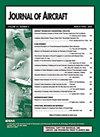基于压力驱动的自适应翼尖气动弹性分析
IF 2.1
3区 工程技术
Q2 ENGINEERING, AEROSPACE
引用次数: 0
摘要
折叠翼尖解决了高展弦比机翼带来的挑战,如机场一致性和翼根弯矩增加。驱动自适应翼尖通过使用在飞行中可主动调节的刚度自适应气动弹性铰链来扩展折叠翼尖的功能。本文的目的是对装有自适应刚度铰链的机翼进行气动弹性分析。虽然基于压力致动蜂窝结构(PACS)的翼尖致动器的结构设计是在以前的研究中开发的,但在本研究中,作者通过气动弹性分析验证了致动自适应翼尖的概念。这项研究表明,所研究的PACS致动器由玻璃纤维增强塑料结构设计,能够承受作用在塞斯纳引文X翼尖上的载荷。自适应刚度铰链位于半翼展的86.7%至91.2%之间,在2.5[公式:见正文]机动载荷情况下,可将翼根弯矩降低7.8%,同时在巡航时保持机翼平直。未来可以通过延长致动器的工作包络线从而增加其承载能力来实现负载减轻潜力的进一步增加。通过气动弹性分析对驱动自适应翼尖概念进行功能验证,为功能原型的制造和测试奠定了基础。本文章由计算机程序翻译,如有差异,请以英文原文为准。
Aeroelastic Analysis of Actuated Adaptive Wingtips Based on Pressure Actuation
Folding wingtips address the challenges posed by high-aspect-ratio wings, such as airport conformity and increased wing root bending moment. Actuated adaptive wingtips extend the functionalities of folding wingtips by using a stiffness-adaptive aeroelastic hinge that is actively adjustable in flight. The objective of this paper is the aeroelastic analysis of a wing equipped with an adaptive-stiffness hinge. While the structural design of the wingtip actuator based on pressure-actuated cellular structures (PACS) was developed in a previous study, in this study the authors verify the concept of actuated adaptive wingtips through aeroelastic analysis. This study shows that the investigated PACS actuator, structurally designed from glass-fiber-reinforced plastic, is capable of bearing the loads acting on the wingtips of a Cessna Citation X. The adaptive-stiffness hinge, positioned between 86.7 and 91.2% of the semispan, reduces the wing root bending moment by up to 7.8% in a 2.5[Formula: see text] maneuver load case, while keeping the wing straight in cruise. A further increase in load alleviation potential can be achieved in the future by extending the actuator’s operating envelope and thus increasing its load-bearing capacity. The functional verification of the actuated adaptive wingtip concept by means of aeroelastic analysis forms the basis for the manufacturing and testing of a functional prototype.
求助全文
通过发布文献求助,成功后即可免费获取论文全文。
去求助
来源期刊

Journal of Aircraft
工程技术-工程:宇航
CiteScore
4.50
自引率
31.80%
发文量
141
审稿时长
6 months
期刊介绍:
This Journal is devoted to the advancement of the applied science and technology of airborne flight through the dissemination of original archival papers describing significant advances in aircraft, the operation of aircraft, and applications of aircraft technology to other fields. The Journal publishes qualified papers on aircraft systems, air transportation, air traffic management, and multidisciplinary design optimization of aircraft, flight mechanics, flight and ground testing, applied computational fluid dynamics, flight safety, weather and noise hazards, human factors, airport design, airline operations, application of computers to aircraft including artificial intelligence/expert systems, production methods, engineering economic analyses, affordability, reliability, maintainability, and logistics support, integration of propulsion and control systems into aircraft design and operations, aircraft aerodynamics (including unsteady aerodynamics), structural design/dynamics , aeroelasticity, and aeroacoustics. It publishes papers on general aviation, military and civilian aircraft, UAV, STOL and V/STOL, subsonic, supersonic, transonic, and hypersonic aircraft. Papers are sought which comprehensively survey results of recent technical work with emphasis on aircraft technology application.
 求助内容:
求助内容: 应助结果提醒方式:
应助结果提醒方式:


